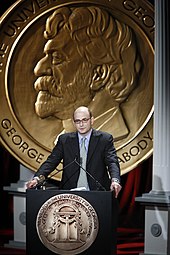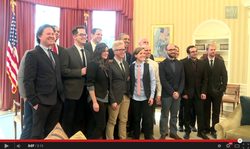Social impact of YouTube
Both private individuals[240] and large production companies[241] have used YouTube to grow audiences. Independent content creators have built grassroots followings numbering in the thousands at very little cost or effort, while mass retail and radio promotion proved problematic.[240] Concurrently, old media celebrities moved into the website at the invitation of a YouTube management that witnessed early content creators accruing substantial followings, and perceived audience sizes potentially larger than that attainable by television.[241] While YouTube's revenue-sharing "Partner Program" made it possible to earn a substantial living as a video producer—its top five hundred partners each earning more than $100,000 annually[242] and its ten highest-earning channels grossing from $2.5 million to $12 million[243]—in 2012 CMU business editor characterized YouTube as "a free-to-use... promotional platform for the music labels".[244] In 2013 Forbes'Katheryn Thayer asserted that digital-era artists' work must not only be of high quality, but must elicit reactions on the YouTube platform and social media.[245]Videos of the 2.5% of artists categorized as "mega", "mainstream" and "mid-sized" received 90.3% of the relevant views on YouTube and Vevo in that year.[246] By early 2013 Billboard had announced that it was factoring YouTube streaming data into calculation of the Billboard Hot 100and related genre charts.[247]
Observing that face-to-face communication of the type that online videos convey has been "fine-tuned by millions of years of evolution", TEDcurator Chris Anderson referred to several YouTube contributors and asserted that "what Gutenberg did for writing, online video can now do for face-to-face communication".[248]Anderson asserted that it's not far-fetched to say that online video will dramatically accelerate scientific advance, and that video contributors may be about to launch "the biggest learning cycle in human history."[248] In education, for example, the Khan Academy grew from YouTube video tutoring sessions for founder Salman Khan's cousin into what Forbes' Michael Noer called "the largest school in the world", with technology poised to disrupthow people learn.[249] YouTube was awarded a 2008 George Foster Peabody Award,[250] the website being described as a Speakers' Corner that "both embodies and promotes democracy."[251] The Washington Postreported that a disproportionate share of YouTube's most subscribed channels feature minorities, contrasting with mainstream television in which the stars are largely white.[252] A Pew Research Center study reported the development of "visual journalism", in which citizen eyewitnesses and established news organizations share in content creation.[253] The study also concluded that YouTube was becoming an important platform by which people acquire news.[254]
YouTube has enabled people to more directly engage with government, such as in the CNN/YouTube presidential debates (2007) in which ordinary people submitted questions to U.S. presidential candidates via YouTube video, with a techPresident co-founder saying that Internet video was changing the political landscape.[255] Describing the Arab Spring (2010– ), sociologist Philip N. Howard quoted an activist's succinct description that organizing the political unrest involved using "Facebook to schedule the protests, Twitter to coordinate, and YouTube to tell the world."[256] In 2012, more than a third of the U.S. Senate introduced a resolution condemning Joseph Kony 16 days after the "Kony 2012" video was posted to YouTube, with resolution co-sponsor Senator Lindsey Graham remarking that the video "will do more to lead to (Kony's) demise than all other action combined."[257]
Conversely, YouTube has also allowed government to more easily engage with citizens, the White House's official YouTube channel being the seventh top news organization producer on YouTube in 2012[260] and in 2013 a healthcare exchange commissioned Obama impersonator Iman Crosson's YouTube music video spoof to encourage young Americans to enroll in the Affordable Care Act (Obamacare)-compliant health insurance.[261] In February 2014, U.S. President Obama held a meeting at the White House with leading YouTube content creators to not only promote awareness of Obamacare[262] but more generally to develop ways for government to better connect with the "YouTube Generation".[258] Whereas YouTube's inherent ability to allow presidents to directly connect with average citizens was noted, the YouTube content creators' new media savvy was perceived necessary to better cope with the website's distracting content and fickle audience.[258]
Some YouTube videos have themselves had a direct effect on world events, such as Innocence of Muslims (2012) which spurred protests and related anti-American violence internationally.[263]TED curator Chris Anderson described a phenomenon by which geographically distributed individuals in a certain field share their independently developed skills in YouTube videos, thus challenging others to improve their own skills, and spurring invention and evolution in that field.[248] Journalist Virginia Heffernan stated in The New York Times that such videos have "surprising implications" for the dissemination of culture and even the future of classical music.[264]
The Legion of Extraordinary Dancers[265]and the YouTube Symphony Orchestra[266] selected their membership based on individual video performances.[248][266] Further, the cybercollaboration charity video "We Are the World 25 for Haiti (YouTube edition)" was formed by mixing performances of 57 globally distributed singers into a single musical work,[267] with The Tokyo Times noting the "We Pray for You" YouTube cyber-collaboration video as an example of a trend to use crowdsourcing for charitable purposes.[268] The anti-bullying It Gets Better Project expanded from a single YouTube video directed to discouraged or suicidal LGBT teens,[269] that within two months drew video responses from hundreds including U.S. President Barack Obama, Vice President Biden, White House staff, and several cabinet secretaries.[270] Similarly, in response to fifteen-year-old Amanda Todd's video "My story: Struggling, bullying, suicide, self-harm", legislative action was undertaken almost immediately after her suicide to study the prevalence of bullying and form a national anti-bullying strategy.[271] In May 2018, London Metropolitan Police claimed that the drill videos that talk about violence give rise to the gang-related violence. YouTube deleted 30 music videos after the complaint.[272]
Promotion of conspiracy theories and fringe discourse
YouTube has been criticized for using an algorithm that gives great prominence to videos that promote conspiracy theories, falsehoods and incendiary fringe discourse.[273] According to an investigation by The Wall Street Journal, "YouTube’s recommendations often lead users to channels that feature conspiracy theories, partisan viewpoints and misleading videos, even when those users haven’t shown interest in such content. When users show a political bias in what they choose to view, YouTube typically recommends videos that echo those biases, often with more-extreme viewpoints."[273] After YouTube drew controversy for giving top billing to videos promoting when people did breaking-news queries during the 2017 Las Vegas shooting, YouTube changed its algorithm to give greater prominence to mainstream media sources.[274][273][275][276] In 2018, it was reported that YouTube was again promoting fringe content about breaking news, giving great prominence to conspiracy videos about Anthony Bourdain's death.[277]
In 2017, it was revealed that advertisements were being placed on extremist videos, including videos by rape apologists, anti-Semites and hate preachers who received ad payouts.[278]After firms started to stop advertising on YouTube in the wake of this reporting, YouTube apologized and said that it would give firms greater control over where ads got placed.[278]
Alex Jones, known for far-right conspiracy theories, has built a massive audience on YouTube.[279] YouTube drew criticism in 2018 when it removed a video from a leftwing watchdog compiling offensive statements made by Jones, claiming that it was "harassment and bullying".[280]
University of North Carolina professor Zeynep Tufekci has referred to YouTube as "The Great Radicalizer", saying "YouTube may be one of the most powerful radicalizing instruments of the 21st century."[281]


Comments
Post a Comment